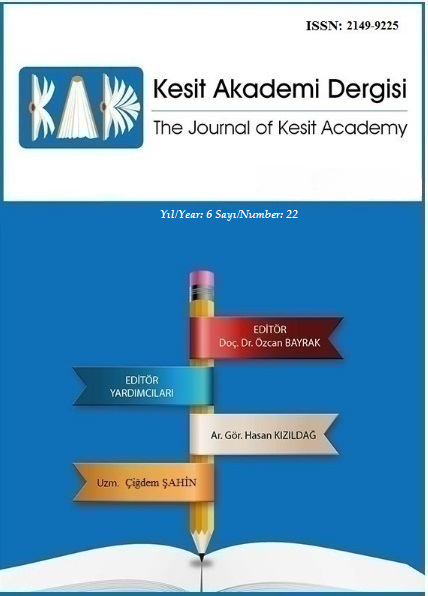Author :
Abstract
15. yüzyılın başlarından 20. yüzyılın başlarına kadar Doğu Türkistan ve Orta Asya Türk devletleri tarafından kullanılan Çağatay Türkçesi beş yüz yıllık süreç boyunca büyük şair ve yazarların yetiştiği bir dönemdir. Bunlar arasında en dikkat çeken isim Ali ޵r Nevāµ’dir. Nevāµ eserleriyle sadece yaşadığı döneme değil daha sonraki yüzyıllara da damga vurmuş biridir. O hem sözlü hem de yazılı edebiyatta adından söz ettirmiş, henüz hayatta iken hakkında pek çok kitap yazılmış hatta eserlerinin anlaşılması amacı ile lügatler tertip edilmiştir. Bunlardan bazıları Bedāyi’ül-lugat, Senglāh, Hulāsa-i Abbāsµ, Fazlu’lālh Han Luġati, Et-Tamga-yı Nāsırµ’dir. Bu sözlükler dışında Nevāyµ’nin eserleri için yazılmış bir lügat daha bulunmaktadır. Bu sözlük Ferheng-i Türkµ-i Çaġatā-µ be Fārsµ’dir. Çalışmamızda Ferheng-i Türkµ-i Çaġatā-µ be Fārsµ adlı eserin ismi, müellifi, nüshaları hakkında bilgi verilecek eserin mukaddime, ana sözlük kısmı ve hatime bölümü örnekler eşliğinde dikkatlere sunulacaktır.
Keywords
Abstract
The period from the beginning of the fifteenth century to the beginning of the twentieth century is a period where great poets and writers who used the Chagatai Turkish used by the East Turkestan and Central Asian Turkish states grew up. Ali ޵r Nevāµ is very significant one of them . Nevāµ is a name that marked not only the period he lived in, but also the later centuries. He has an important place in both oral and written literature, so many books have been written about him while he is still alive, and dictionaries were written to understand his works. Some of them are Bedāyi'ül-lugat, Senglāh, Hulāsa-i Abbāsµ, Fazlu'lālh Han Luġati, Et-Tamga-yı Nāsırµ. Apart from these dictionaries, there is another dictionary written for Nevāµ's works. This dictionary is Ferheng-i Türkµ-i Çaġatā-µ be Fārsµ. In this study, the information about its name, author and copies will be given and the main dictionary part of the work and the epilogue part will be examined through examples.
Keywords
- Alî Şîr Nevâyi. (2002). Bedâyi῾ü’l-Vasat, üçünçi dîvân, Haz. Kaya Türkay. Ankara: Türk Dil Kurumu Yayınları.
- Devellioğlu, Ferit. (2002). Osmanlıca-Türkçe Ansiklopedik Lûgat. Ankara: Aydın Kitabevi Yayınları.
- Eckman, Janos. (1957). ‚Mirza Mehdi’nin ‚Senglâh‛ Adlı Çağatayca Sözlüğü‛ VIII. Türk Dil Kurultayında Okunan Bilimsel Bildiriler. Ankara: Türk Tarih Kurumu Basımevi, 37-40.
- Ed-Derâbitî, Mustafa. (2011). El-Fihrisü’l-Muva id lil-Ma û âti’l-Îrâniyyeti. İran: Kütâbḫâne-yi Milliyi Cumhurî İslâmî.
- Eminoğlu, Emin. (2010). Türk Dilinin Sözlükleri ve Sözlükçülük Kaynakçası. Sivas: Asitan Yayıncılık.
- Kanar, Mehmet. (2000). Farsça-Türkçe Sözlük. İstanbul: Deniz Kitabevi.
- Kara, Funda. (2011). Zebân-ı Türkî (Kèlür-nâme). Erzurum: Fenomen Yayınları.
- Kargı Ölmez, Zuhal. (1998). ‚Çağatayca Sözlükler‛. Kebikeç, S. 6, 137-144.
- Münzevî, A med. (1350/1971). Nüsḫahâ: Fihrist-i Nüsḫahâ-yi Ḫa -i Fârsî, C. III. Tahran.
- Öz, Yusuf. (2016). Tarih Boyunca Farsça-Türkçe Sözlükler. Ankara: Türk Dil Kurumu Yayınları.
- Özkan, Fatma. (1996). ‚Nevayi Eserleri İçin Yazılmış Bir Lügat Der Beyân-ı Istılâhât-ı Emlahu῾şuarâ Mevlânâ Nevâyi”. Bilig 1, Bahar, 198-243.
- Rahimi, Farhad. (2017). ‚İran Kütüphanelerinde Bulunan Çağatay Türkçesi Sözlükleri‛. Uluslararası Türkçe Edebiyat Kültür Eğitim Dergisi, S. 6/4, 2067-2079.
- Rahimi, Farhad. (2018). ‚Çağatay Türkçesi Sözlükleri Bibliyografyası‛. Uluslararası Türkçe Edebiyat Kültür Eğitim Dergisi, S. 7/1, 69-104.
- Ünlü, Suat. (2013). Çağatay Türkçesi Sözlüğü. Konya: Eğitim Kitabevi.
